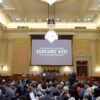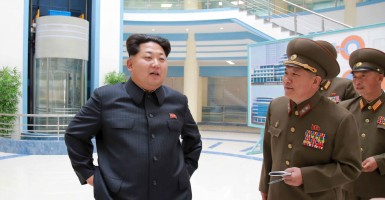While the White House winds up its deal on the future of Iran’s nuclear program, angst abounds in U.S. national security circles. Contributing to the anxiety over how the Tehran regime will act in the future is knowledge of how the Pyongyang regime has acted in the past.
For years, the North Korean government dabbled in deals and threats, stringing along the international community, until it became an established nuclear weapons power. Who is to say Iran isn’t playing the same game? In the end, the U.S. could wind up with two nuclear headaches instead of one.
And, make no mistake, even though the West is focusing on Iran and devoting precious little attention to the Land of the Morning Calm, the situation in Northeast Asia looks not so calm. In fact, it is likely to get touchier in the near future. (North Korea has a propensity for provocation when it feels it’s not getting the attention it deserves.)
For starters, there is a rather unsettling debate going among analysts over just how much Pyongyang’s nuclear weapons program has progressed since it declared the Six-Party Talks, tasked with denuclearization of the peninsula, “null and void.” (One step ahead of Tehran, Pyongyang has given up the hoary pretense that it might be persuaded to jettison its nuclear arsenal.)
And what Pyongyang already has is not insignificant. Most analysts estimate North Korea already has between one- and two-dozen nuclear warheads. Further, few doubt they plan to build more. A report earlier this year from Joel S. Wit and Sun Young Ahn for the Korea Institute at the Johns Hopkins School of Advanced International Studies presents a worst-case scenario. In five years, they forecast, the regime could have 100 nuclear weapons. North Korea has increasing options for pairing warheads with weapons, including large fleets of medium and intermediate range ballistic missiles, as well as an on-going intercontinental ballistic missile development program. Additionally, earlier this year press reports held that the regime was undertaking preliminary testing for a submarine-launched nuclear weapon. Even more worrying, North Korean officials have claimed they have made weapons small enough to fit on a missile. This year, the four-star commanders of U.S. Forces Korea, U.S. Pacific Command, and NORAD have all publicly assessed that North Korea has the ability to put a nuclear warhead on an ICBM.
While pundits debate just how much there is to worry about from a nuclear Tehran in the future, there isn’t much question that there is a real and growing menace in Northeast Asia right now—and calming fears over the North Korea weapons program ought to be a much higher priority. South Korea and Japan are America’s anchor to Asia. Leaving these two key allies to squirm under the shadow of a North Korean nuclear threat ought to be out of the question.
A counter-intimidation strategy ought to start with missile defense. The capacity to defend against incoming missiles is a crucial palliative. There are both academic research and real-world experience make that case.
In 2004, a group called the Nuclear Stability Working group developed a model to test how to avert armed exchanges in an environment where multiple independent players had nuclear arsenals. The scenario they framed mirrored conditions in Northeast Asia—but made them even worse by proliferating arms among additional states. After several rounds of gaming how nations might respond to provocations under these conditions, the report concluded that the more widely missile defenses were proliferated, the less likely players were to take offensive action. The most resilient deterrence came from players that maintained a healthy “offense-defense” mix—in other words nuclear weapons and missile defenses. Under these conditions, players felt most confident they could defend themselves and therefore were less likely to escalate confrontations and risk widening the war.
There are real-life examples of this dynamic at work. For example, some argued that when Israel deployed the Iron Dome system to protect its citizens from rockets fired by Hamas, the Israeli government would concomitantly be less likely to respond with indiscriminate overwhelming force when their own citizens were under threat. This seems to be exactly how the Israeli’s responded. “The decision to avoid a ground operation can be credited mainly to Iron Dome,” concluded a research report published in Military and Strategic Affairs, “which helped protect the Israeli home front more effectively than in the past and thus helped reduce public pressure on the government. This in turn gave the government more time to make decisions.” Neither finding suggests that missile defense is an Easy button that will make problems go away. But it’s a start.
For this reason, South Korea ought to ask for deployment of the Terminal High Altitude Area Defense (THAAD)—and the U.S. ought to oblige. This would add a layer of missile defense against short and medium range missiles, filling a dangerous gap in Seoul’s defense and giving it confidence that it could fend off a North Korean attack.
“A basic precept of air and missile defense is ‘mass and mix’—having sufficient interceptors from different systems so that any one system’s vulnerabilities are offset by the capabilities of another system,” writes Bruce Klingner, a defense analyst who has done an extensive assessment of the impact THAAD would have on the strategic balance in the region.
Not surprisingly, neither China nor Russia is thrilled with the idea of the U.S. extending missile defenses to its Asian allies. That’s because they like having South Korea and Japan feel vulnerable. To be blunt, Moscow and Beijing’s position—as expressed in the joint 2013 statement insisting that “the unilateral and unchecked buildup of anti-missile capabilities by a country or a group of countries [will work] to the detriment of strategic stability and international security”—seems more like a self-serving attempt at intimidation than a serious argument.
THAAD is a wholly defensive system that poses no threat to any nation. On the other hand, it can serve as a potent aid in deterring North Korean nuclear blackmail. Without capabilities like THAAD, South Korea and the whole region will become increasingly unsafe as North Korea becomes increasingly dangerous.



























